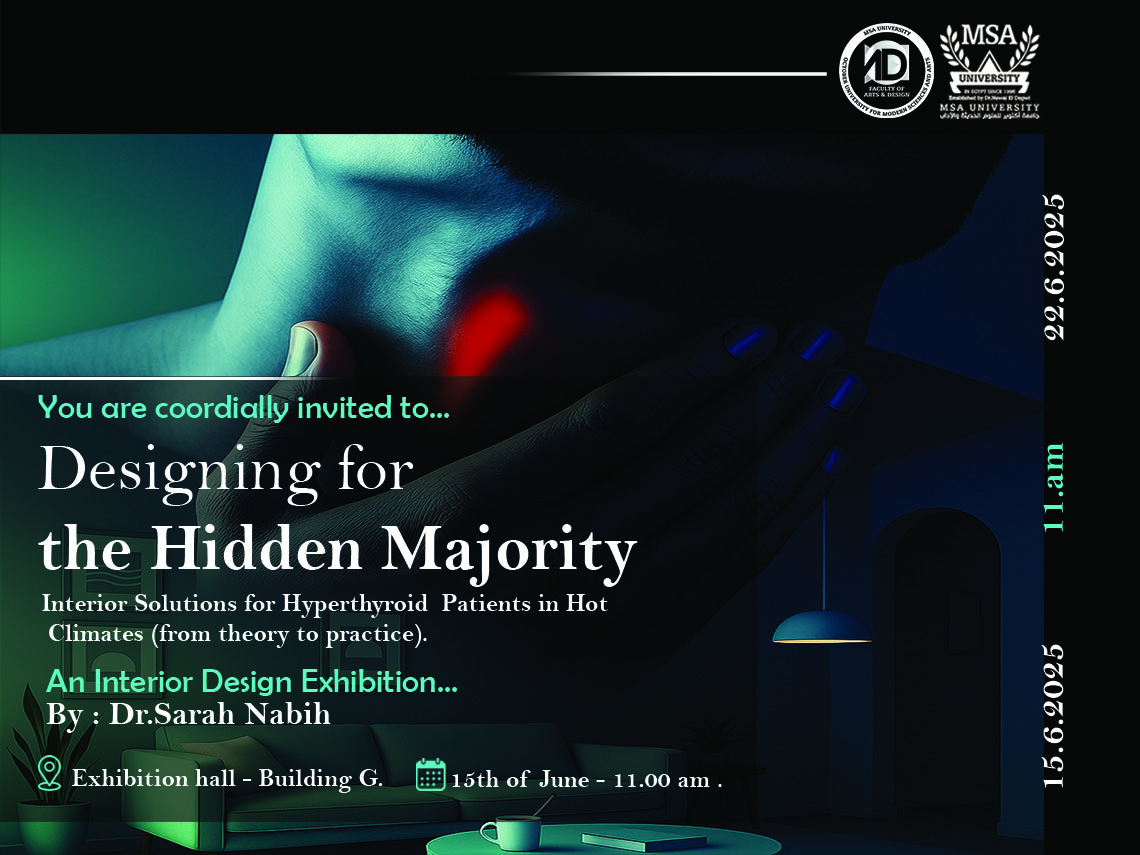The Interior Design Department at the Faculty of Arts and Design at October University for Modern Sciences and Arts (MSA) is inviting you to the interior design exhibition led by Dr. Sarah Nabih, entitled “Designing for the Hidden Majority: Interior Solutions for Hyperthyroid Patients in Hot Climates Interior solutions for hyperthyroid patients in hot climates (from theory to practice)”
Main idea of the exhibition: This exhibition uncovers the transformative potential of interior design for hyperthyroid patients, a frequently overlooked group. By taking research-based design principles from theory to real- world application, it presents innovative solutions specifically designed for home office spaces in hot climates. Using insights from mood boards and a scenario-based visual preference survey, the exhibition captures the voices and preferences of hyperthyroid individuals—showing how thoughtful design can reduce stress, heat sensitivity, and discomfort.
Event Purpose: Design can do more than look good—it can heal.
“Designing for the Hidden Majority” is not just an exhibition; it’s a wake-up call. This groundbreaking showcase reveals how thoughtful interior design can cool the space, calm the mind, and comfort the body—specifically for people who live with hyperthyroidism or heat sensitivity.
The event takes scientific research out of the lab and into real rooms, transforming theory into tested, real-world solutions. From soothing color palettes to material choices that fight heat and stress, each space is crafted with empathy and precision—because everyone deserves to feel good in their own space. This isn’t just about interiors. It’s about well-being, inclusivity, and sustainability—where design meets purpose and every detail matters.
The exhibition offers a powerful blend of empathy, innovation, and real-world relevance by putting a spotlight on a long-overlooked group—hyperthyroid patients—and addressing their specific needs through user-tested, health-focused interior design. It translates academic research into practical, visually engaging design scenarios that have been evaluated by real patients, ensuring every solution is both grounded and impactful. By promoting thermal comfort and reducing environmental stress, the exhibition highlights how design can directly support both physical and mental well-being—especially in hot climates. It also serves as an educational tool for designers and practitioners, providing a blueprint for more inclusive and responsive interiors that prioritize wellness. Fully aligned with the UN’s Sustainable Development Goals—namely, SDG 3 (Good Health and Well-being) and SDG 11 (Sustainable Cities and Communities)—the project emphasizes sustainability by showcasing low-energy, passive design strategies using smart materials and calming color palettes. With its fusion of research depth, visual clarity, and real human stories, the exhibition is a compelling experience for professional
Benefits and value The exhibition offers a powerful blend of empathy, innovation, and real-world relevance by putting a spotlight on a long-overlooked group—hyperthyroid patients—and addressing their specific needs through user-tested, health-focused interior design. It translates academic research into practical, visually engaging design scenarios that have been evaluated by real patients, ensuring every solution is both grounded and impactful. By promoting thermal comfort and reducing environmental stress, the exhibition highlights how design can directly support both physical and mental well-being—especially in hot climates. It also serves as an educational tool for designers and practitioners, providing a blueprint for more inclusive and responsive interiors that prioritize wellness. Fully aligned with the UN’s Sustainable Development Goals—namely, SDG 3 (Good Health and Well-being) and SDG 11 (Sustainable Cities and Communities)—the project emphasizes sustainability by showcasing low-energy, passive design strategies using smart materials and calming color palettes. With its fusion of research depth, visual clarity, and real human stories, the exhibition is a compelling experience for professionals, students, and the public alike, sparking a necessary conversation about who we design for—and how.

